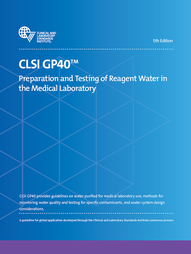CLSI GP40
Preparations and Testing of Reagent Water in the Medical Laboratory
CLSI GP40 offers essential guidelines for the use of purified water in medical laboratories. It covers methods for monitoring water quality, testing for specific contaminants, and important consideratoins for water system design. This comprehensive resource ensures that your laboratory meets the highest standards of water purity and safety.
{{FormatPrice(currentPrice)}}
Free
{{FormatPrice(nonMemberPrice)}} List PriceClinical and Laboratory Standards Institute GP40—Preparation and Testing of Reagent Water in the Medical Laboratory provides information on water purity requirements for medical laboratory testing, validation of specifications, technology available for water purification, and test procedures to monitor and trend water purity parameters.
CLSI GP40 was revised in 2024 under the Limited Revision Process and replaces the 4th edition of the guideline, which was published in 2012. Several changes were made in this edition, including:
• Adding information for SRW for molecular biology measurement procedures
• Providing additional details regarding verification of commercially available bottled purified water
• Updating water monitoring to include electronic monitoring of water and records as well as electronic warnings to alert for water purification equipment maintenance before failure
• Providing additional information on testing water for microbial contamination
• Adding as Appendix A a comparison of specifications in CLSI GP40 with ASTM International specifications
• Relocating to Appendix B technical details for sparging to remove dissolved CO2 when necessary to measure resistivity
• Relocating to Appendix D technical details for epifluorescence assessment of microbial contamination
• Relocating to Appendix E technical details for endotoxin testing
A number of types of purified water for use in medical laboratory testing procedures are specified:
• Clinical laboratory reagent water (CLRW)
• Special reagent water (SRW)
• Molecular biology water, a type of SRW
• Instrument feed water
• Water supplied by a method manufacturer
• Autoclave and wash water
• Commercially bottled, purified water
Procedures are provided for measuring parameters that monitor ionic, organic, and microbial contamination in purified laboratory water. These parameters should be monitored over time to identify trends in performance so corrective action can be taken before a parameter exceeds specified limits. Recommendations are provided to control particulate and colloidal contamination. CLSI GP40 includes validation by the laboratory that a selected type of water is fit for its intended purpose. Suggested approaches for validation of water purification systems are included.
It is beyond the scope of CLSI GP40 to recommend specific types of water purification systems. Instead, CLSI GP40 provides information about discrete purification technologies and monitoring strategies that can be applied in various combinations to achieve and maintain the necessary water purity.
Clinical and Laboratory Standards Institute GP40—Preparation and Testing of Reagent Water in the Medical Laboratory provides information on water purity requirements for medical laboratory testing, validation of specifications, technology available for water purification, and test procedures to monitor and trend water purity parameters.
CLSI GP40 was revised in 2024 under the Limited Revision Process and replaces the 4th edition of the guideline, which was published in 2012. Several changes were made in this edition, including:
• Adding information for SRW for molecular biology measurement procedures
• Providing additional details regarding verification of commercially available bottled purified water
• Updating water monitoring to include electronic monitoring of water and records as well as electronic warnings to alert for water purification equipment maintenance before failure
• Providing additional information on testing water for microbial contamination
• Adding as Appendix A a comparison of specifications in CLSI GP40 with ASTM International specifications
• Relocating to Appendix B technical details for sparging to remove dissolved CO2 when necessary to measure resistivity
• Relocating to Appendix D technical details for epifluorescence assessment of microbial contamination
• Relocating to Appendix E technical details for endotoxin testing
A number of types of purified water for use in medical laboratory testing procedures are specified:
• Clinical laboratory reagent water (CLRW)
• Special reagent water (SRW)
• Molecular biology water, a type of SRW
• Instrument feed water
• Water supplied by a method manufacturer
• Autoclave and wash water
• Commercially bottled, purified water
Procedures are provided for measuring parameters that monitor ionic, organic, and microbial contamination in purified laboratory water. These parameters should be monitored over time to identify trends in performance so corrective action can be taken before a parameter exceeds specified limits. Recommendations are provided to control particulate and colloidal contamination. CLSI GP40 includes validation by the laboratory that a selected type of water is fit for its intended purpose. Suggested approaches for validation of water purification systems are included.
It is beyond the scope of CLSI GP40 to recommend specific types of water purification systems. Instead, CLSI GP40 provides information about discrete purification technologies and monitoring strategies that can be applied in various combinations to achieve and maintain the necessary water purity.
